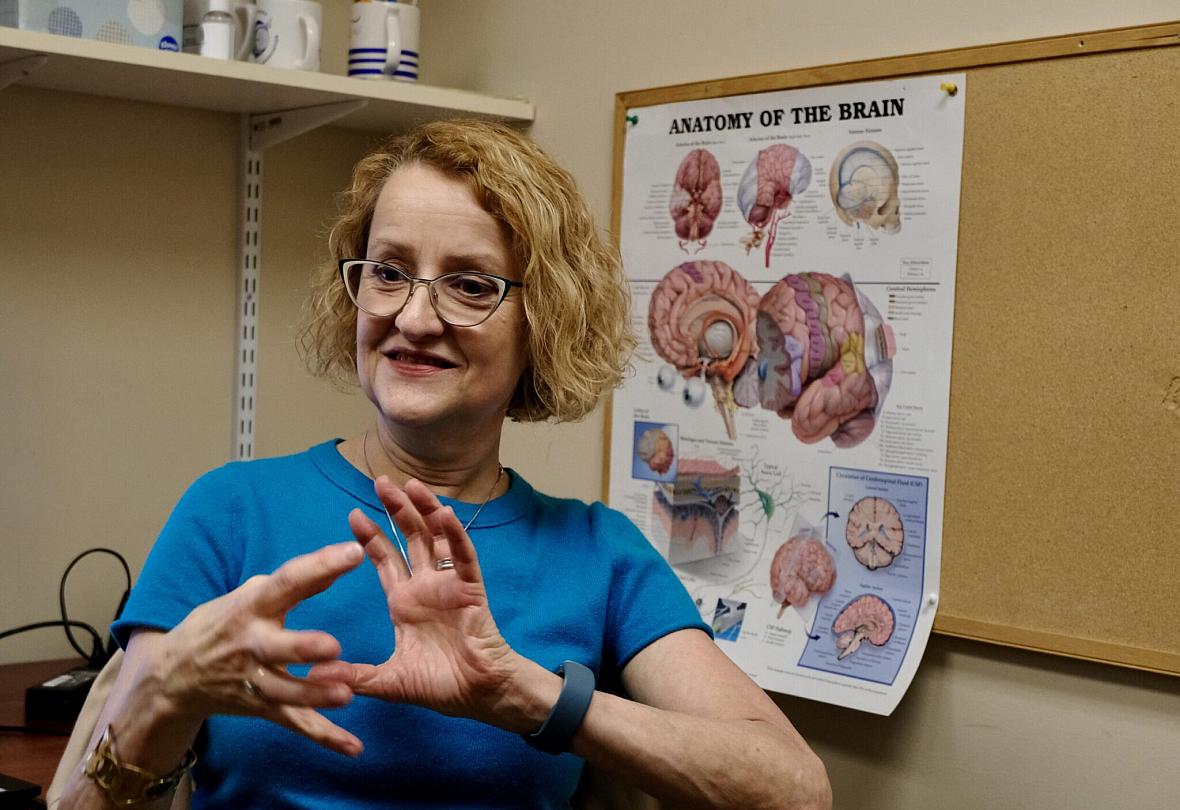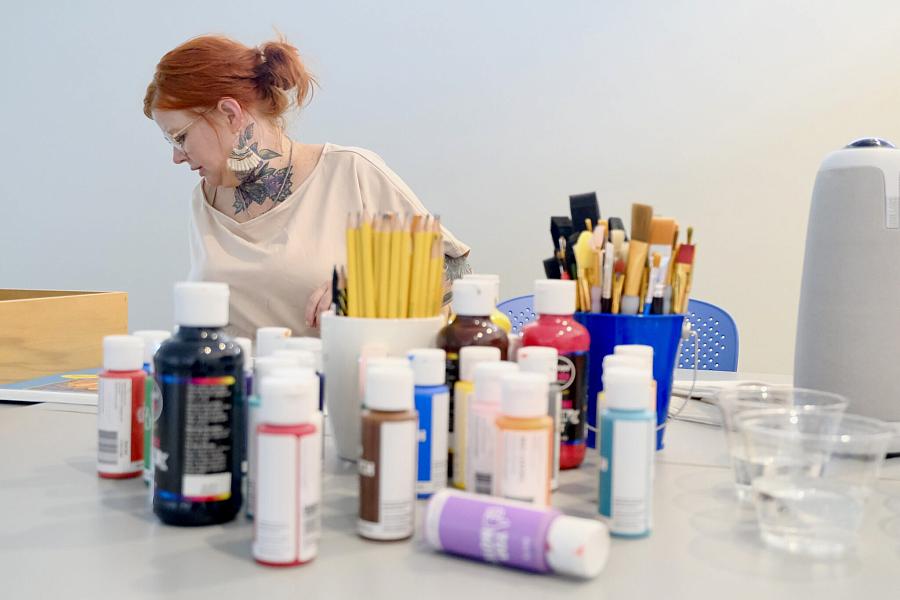Advocates link Alaska’s high rate of traumatic brain injury with domestic violence
This project was originally published in Alaska Beacon with support from our 2023 Domestic Violence Impact Fund.

Patty Raymond-Turner, a coordinator for the Brain Injury Council of Alaska, demonstrates what happens to the brain when it is injured, on Sept. 26, 2023, in Anchorage.
(Photo by Claire Stremple/Alaska Beacon)
S. can’t remember how many times she has been hit in the head, but she remembers vividly the time she was choked. Those are two categories of injury she has survived over the course of her abusive marriages, and they are distinct because they can cause or contribute to traumatic brain injury.
“I attract sociopaths, not abusers,” she said from her art-filled room in permanent supportive housing in Interior Alaska. “Sociopaths.”
One of her husbands threw her down a flight of stairs. Her last boyfriend tried to strangle her. The Alaska Beacon is not naming her for safety reasons — one of her abusers has tracked her to her new home before. S. speaks quickly, but pauses frequently and often cannot remember where she left off. “Brain stop,” she said at one point, or, another time, “I apologize, my brain is like—” and then muddled her fingers together in a jumbled gesture.
S.’s body is a map of scars from abuse that spans from childhood until she made it to shelter just under a decade ago. She is visibly wracked with pain, and said she rarely sleeps.
“I’m brain damaged from abuse. I don’t claim the brain damage, though,” she said. “It’s not on my medical record. I don’t want another disability. I’ve got too many going on.”
Alaska has the highest rate of deaths from traumatic brain injury in the nation and among the highest rates of domestic violence, but it is only recently that advocates and caregivers began to link the two. And as S.’s story bears out, as high as the Alaska rates are for both traumatic brain injury and domestic violence, experts have said they are undercounted.
‘They’re not going crazy. This is a real medical diagnosis.’
Few people who provide services understand the link between traumatic brain injury and domestic violence better than Kimberly Sumner, who manages the state’s Traumatic and Acquired Brain Injury grant program in Juneau. She identifies as a survivor of both TBI and of domestic violence. Now she helps other people who have sustained trauma.

Kimberly Sumner prepares for an art-based support group session for people with traumatic brain injury on Aug. 16, 2023, in Juneau, Alaska.
(Photo by Claire Stremple/Alaska Beacon)
“I knew that the lack of services in the community for people with traumatic brain injuries was huge, but I didn’t know how huge it was. And I also saw a great need for it,” she said.
Sumner worked in victim’s services with Juneau’s domestic violence shelter for more than a dozen years. She said she saw evidence of brain injury among many of the people she helped, but there wasn’t a specific screening that might help them get a diagnosis. Now, she works with Southeast Alaska Independent Living and can connect clients to resources, like the state grant she manages and a number of support groups she runs.
Since 2003, the state has managed a program that awards grants to support people who have sustained traumatic brain injuries. One-year grants can be up to $2,500 or awardees can receive up to $5,000 over five years.
The grant program is not new, but Sumner’s approach is, said her supervisor, Bridget Thompson.
“What the other agencies don’t do as much as we do here — and it’s because of Kim’s background — is that awareness around domestic violence,” she said. “Everything that Kim brought to the traumatic and acquired brain injury program is from her lived experience.”
Thompson said that when people think of traumatic and acquired brain injuries, they consider causes like car accidents, strokes and concussions, “but very rarely are people thinking of domestic violence or any sort of emotional abuse. And that’s something that’s totally different than the other programs throughout the state.”
Another thing that Sumner does for clients sounds simple: She listens. But she listens without judgment, she said, because she has experienced trauma, and understands how devastating it can be.
Sumner also uses art as therapy. One afternoon, after hosting a small group at a support meeting, she sat among the leftover snacks, colored pencils and painting supplies.
“I think it just takes one voice at a time to get the word out there,” she said. “I want to be there for the survivors. I want them to know: They’re not alone. And they’re not going crazy. This is a real medical diagnosis. And they have lots of support out there.”
Invisible wound
Patty Raymond Turner, a traumatic brain injury expert with the University of Alaska’s Center for Human Development, has devoted her career to raising awareness about TBI.
As part of a statewide campaign, she compiled the numerous symptoms of TBI in a brochure. It reads like a list of common complaints from women who have experienced domestic violence or trauma, and there is overlap with the symptoms of post traumatic stress syndrome: trouble sleeping and concentrating, mood changes, memory issues.
There is data to track traumatic brain injury and data to track domestic violence, but not much that tracks the overlap, she said.
“It tends to be kept hidden, especially in Alaska,” she said of domestic violence.
Research in this area is scarce, but an Ohio study showed that among victims of domestic violence, 85% experienced blows to the head — of those, it happened to half of them more times than they could count. Further, 83% experienced strangulation, which can also cause traumatic brain injury. A national study found that 80% of domestic violence victims have sustained multiple traumatic brain injuries, but only about 20% sought medical attention at the time of an injury.
Maybe they’re thinking, ‘That’s just my emotions, because of the quality of my relationship,’ and they’re not making the connection that it might be because they've been hit in the head over and over again. Patty Raymond Turner, University of Alaska Center for Human Development
Raymond Turner’s mission is to make sure people with brain injuries know they have them and can get help, no matter the cause.
“TBIs, whether they’re mild or severe, can seriously disrupt people’s lives. And sometimes they don’t know what’s causing the issues,” she said.
“Sometimes people don’t know what’s causing it and they don’t know how to help make it better. And it can impact their personal lives. You know, relationships with their spouse or partner or kids.”
Raymond Turner added that not everybody has all of the symptoms. Some people only experience one or two of them. She said control by an abuser is one of the main reasons women do not or cannot report their injury, but other reasons include shame, and a lack of awareness about the link between the violence and brain injury symptoms.
“Maybe they’re having trouble concentrating, they’re having trouble remembering things, they feel really anxious,” she said. “Maybe they’re thinking, ‘That’s just my emotions, because of the quality of my relationship,’ and they’re not making the connection that it might be because they’ve been hit in the head over and over again.”
She said even though Alaska has very high rates of TBI, she knows it goes largely unreported.
A tool for change
But that may soon change, as awareness grows. Kelley Hartlieb, a project coordinator for the University of Alaska Anchorage’s Center for Human Development, is part of the team that is working on the Alaska State Plan for Brain Injury.
“Recognizing that survivors of interpersonal violence are people who experience brain injury at an increased rate, my part in the project is to develop a screening tool,” she said.
That facet of the work has taken off in the last two years, she said. The goal is for victim advocates to understand the intersection between domestic or intimate partner violence and brain injuries — and how to better help clients who have them.
The tool is called BASKETS, which is an acronym for the ways people might acquire a TBI or next steps they might take:
- Brain bumped, banged, beaten, bruised?
- Acquired and injured in other ways?
- Strangled, suffocated, stopped breathing?
- Knocked out?
- Emergency services ever encouraged?
- Trouble now?
- Support, services, self-advocacy, self-care.
Hartlieb used to work with the Anchorage domestic violence shelter, and she said advocates didn’t know to screen people for traumatic brain injury. The tool she’s developing will allow them to do that.
Shelters can be noisy, busy, light-filled places, Hartlieb said, which can be a painful environment to navigate for someone with traumatic brain injury, who may be sensitive to all of those factors.
Hartlieb said the state and advocacy groups haven’t been tracking traumatic brain injury among people who survive domestic violence, even though blows to the head and strangulation are known to be very common injuries among that population.
“Usually it’s repeated concussive incidents that people get and that makes it harder and harder for them to recover. It makes them more and more vulnerable and susceptible to continued increasing injury,” she said. “Some of the impacts make them even more susceptible to abuse because it can often result in foggy memory or lack of attention span, forgetfulness, tiredness and fatigue and all of these symptoms that then the perpetrator can say, ‘You’re nuts. You’re crazy.’”
Her experience working with survivors taught her that perpetrators can use cognitive difficulties against their victims by telling them that they’re stupid, lazy or unfit to care for their children, when in reality the victims are trying to function after brain injury.
“They might think, ‘He’s right, because I can’t keep it together and I’m having trouble,’” Hartlieb explained. “It might be an ‘aha moment’ to say, ‘You know what? Maybe you’ve got something that you can get some support around. You’re not lazy or stupid. It’s the impact, potentially, of something going on in your brain.”
Hartlieb has shown it to some people in the field, and said they are clamoring for the tool. It isn’t in use yet, but the Center for Human Development aims to have it in a pilot program in the Anchorage shelter by the end of the year.
There are supports for people with brain injury in Alaska:
- Access Alaska: Anchorage 907-248-4777, Mat-Su 907-357-2599, Fairbanks 907-479-7940
- Independent Living Center: PeninsulaILC.org or 907-235-7911
- Maniilaq Association: maniilaq.org or 907-442-7887
- Southeast Alaska Independent Living (SAIL): info@sailinc.org or 800-478-7245
- BrainMattersAK.com
- Brain Injury Association of Alaska: biaak.org


